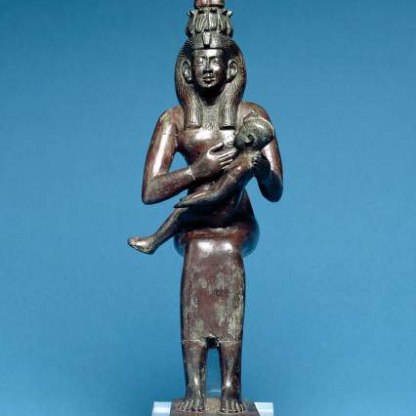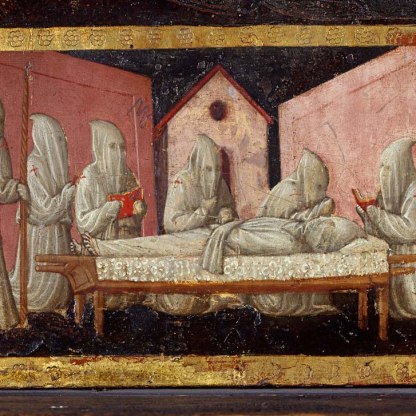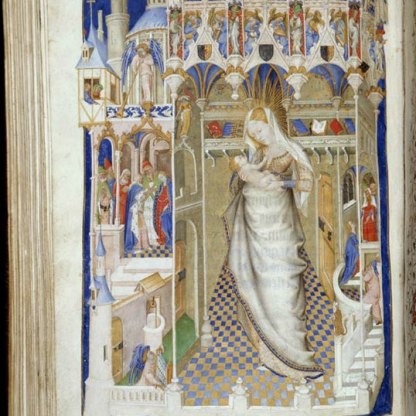Tabernacle

Everyone is to sit down and the sacristan will hand out the whips. Then the governor shall give a sermon, and the brothers shall whip themselves fervently.
This quotation comes from a document written in Florence in 1456. It describes, in detail, the order of service for one of the several flagellant orders in the city, associations of professional lay men, who would express their Christian devotion by flogging themselves. The remarkable scene depicted at the bottom of the main panel of Paolo di Stefano's tabernacle shows the funerary rites of a member of just such an order.
Intriguing though it is, the funeral scene is subordinate to the main picture of the Virgin and Child. As was common in the fifteenth century in Italy, the humanity of Mary and Jesus is emphasised here. Mary is a 'Madonna of Humility', seated on the floor, holding her son who, with his blonde, curly hair and his hand held up to his mouth, is a thoroughly believable toddler. His divinity, however, and the death he will suffer, are alluded to in his – now faded – halo which contains a cross. Beside the Madonna and Child, a gold vessel holds a lily, the traditional symbol of Mary's virginity.
Along the top of the curving frame, four angels play musical instruments.
This main picture is flanked by saints. At the left St Francis of Assisi is depicted below St Mary Magdalene. To the right is St Jerome, and above him a figure in a white habit, holding a crozier and book.
Beneath the funeral scene an inscription reads 'Adoramus te Domine VHS XRE' – 'We worship you, Lord Jesus Christ'. And further down, on the curving underside of the tabernacle, Adam and Eve stand naked in a dark wood on either side of a tree around which a human-headed snake winds. The serpent faces Eve as she scoops a spoonful of the forbidden fruit into her mouth. Two coats of arms hang from the tree. Now defaced and unidentifiable, it is possible that they belonged to the man whose funeral is eternally re-enacted on the picture above.
Against a dark sky, outside a pink building, a corpse is laid out on a bier. Around it are gathered eleven figures. All have bare feet and all are identically dressed in white robes decorated with red crosses. These are surmounted by pointed, white hoods that entirely obscure the wearers' features. Five of the men kneel, and of the six who stand, one has pulled aside his hood to allow himself to read from a book (detail left).
Resembling as it does the uniform of the Klu Klux Klan, there is perhaps, to modern eyes, something unsettling about the appearance of these men. In fact the flagellants' uniform was intended primarily to render each man anonymous and equal, his personal identity subordinated to that of the group. The flagellant confraternities were well known for their privacy. The simple pink edifice outside which the funeral takes place, probably represents the oratory of this particular order, but it is an unostentatious building, its religious function suggested only by the round window above the door.
Themes and periods
Data from our collections database
Tabernacle, with a complete cycle of sin and redemption, made for a Flagellant company
Cav. Giuseppe Toscanelli, Pisa; his sale, Florence, 9-23 April 1883 (132), bt. Charles Butler
Acquisition and important dates
- Method of acquisition: Bought
- Dates: 1893
Dating
- 1440s
- Production date: not before AD 1440
Maker(s)
Materials used in production
Read more about this recordStories, Contexts and Themes
Other highlight objects you might like
Suggested Curating Cambridge products
Sign up to our emails
Be the first to hear about our news, exhibitions, events and more…







